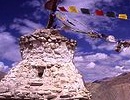Buddhism and Royal Religion
 The group’s research into sutra copying is precisely where the first theme of the project overlaps with its second theme. Here, concern with codicology, palaeography, and orthography overlap with larger questions about the use of sutras as ritual objects, and in particular as royal gifts. This overlap between the first two themes lies also in the first theme’s ambition to draw an accurate portrait of Tibetan kingship during the period of the Tibetan Empire. The second theme, the Buddhist transformation of Tibetan kingship, intervenes here for the simple fact that we have no pre-Buddhist Tibetan written sources. Even our earliest datable inscriptions, from approximately 764, do not predate the presence of Buddhism in Tibet. Moreover, non-Buddhist ritual texts, which scholars often mine unreflectively for information about “pre-Buddhist” Tibetan rituals and practices, or “pre-Buddhist Bon religion,” may owe their very existence, that is, their being textualized and transmitted in written form, to the influence of Buddhism and the cultic power of the Buddhist book. Their contents, too, particularly as regards animal sacrifice, may reflect a situation where non-Buddhist rituals and cosmologies are already on the defensive, and are responding to Buddhist critiques. In short, Buddhism is already present in all written depictions of Tibetan kingship and ritual, even if only in the form of a shadow lying over them.
The group’s research into sutra copying is precisely where the first theme of the project overlaps with its second theme. Here, concern with codicology, palaeography, and orthography overlap with larger questions about the use of sutras as ritual objects, and in particular as royal gifts. This overlap between the first two themes lies also in the first theme’s ambition to draw an accurate portrait of Tibetan kingship during the period of the Tibetan Empire. The second theme, the Buddhist transformation of Tibetan kingship, intervenes here for the simple fact that we have no pre-Buddhist Tibetan written sources. Even our earliest datable inscriptions, from approximately 764, do not predate the presence of Buddhism in Tibet. Moreover, non-Buddhist ritual texts, which scholars often mine unreflectively for information about “pre-Buddhist” Tibetan rituals and practices, or “pre-Buddhist Bon religion,” may owe their very existence, that is, their being textualized and transmitted in written form, to the influence of Buddhism and the cultic power of the Buddhist book. Their contents, too, particularly as regards animal sacrifice, may reflect a situation where non-Buddhist rituals and cosmologies are already on the defensive, and are responding to Buddhist critiques. In short, Buddhism is already present in all written depictions of Tibetan kingship and ritual, even if only in the form of a shadow lying over them.

